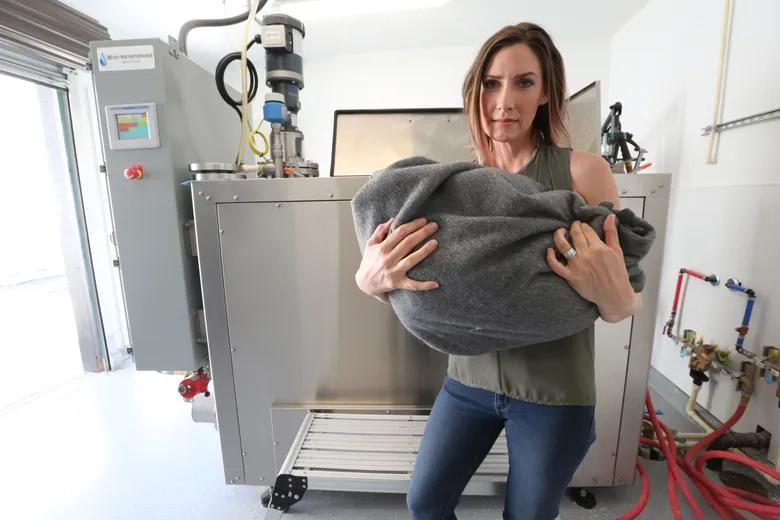Aquamation, or alkaline hydrolysis, is an eco-friendly pet disposal method using water, heat, and alkaline chemicals. This alternative to traditional cremation reduces carbon emissions and preserves nutrients. Upgrades and training are needed for aquamation integration in crematoriums. Addressing concerns is crucial for promoting understanding and acceptance. Aquamation enhances pet care sustainably, reducing emissions and preserving ashes. Investigate how aquamation elevates pet crematoriums.
Key Takeaways
- Aquamation offers an eco-friendly method for pet disposal, reducing carbon emissions and preserving nutrients.
- Upgrading facilities and training staff ensures seamless integration of aquamation services in crematoriums.
- Education and transparency address concerns about aquamation, promoting understanding and acceptance.
- Aquamation enhances pet care by providing a more compassionate and environmentally conscious alternative to traditional cremation.
- Utilizing water and alkaline hydrolysis, aquamation accelerates decomposition, offering a respectful farewell for pets.
Understanding Pet Aquamation
Pet aquamation process, known as alkaline hydrolysis, is a scientifically advanced and environmentally friendly method for the respectful disposition of deceased pets. This process involves placing the pet in a specialized chamber where water, heat, and alkaline chemicals are used to accelerate the natural decomposition process. The result is a gentle and eco-conscious alternative to traditional pet cremation methods.
Benefits of Pet Aquamation
The benefits of using the aquamation method for pet disposal are based on its environmentally friendly characteristics and the kind way in which it speeds up the natural decomposition process. Aquamation is a gentle and eco-conscious alternative to traditional cremation, utilizing water and alkaline hydrolysis to break down tissues. This process results in reduced carbon emissions, preservation of nutrients, and a more respectful farewell for beloved pets.
Implementing Aquamation in Crematoriums
Implementing aquamation technology in crematoriums requires careful consideration of infrastructure upgrades and staff training to e seamless integration of this eco-friendly method for pet disposal. Upgrading facilities to accommodate aquamation equipment and providing thorough training for staff members are e steps in successfully incorporating this e process into existing crematorium operations. Attention to detail in implementation is vital for a smooth transition to aquamation services.
Addressing Concerns About Aquamation
In the domain of pet aftercare services, addressing common concerns regarding the aquamation process is essential for promoting understanding and acceptance among pet owners and industry professionals. Clarifying misconceptions about the environmental impact, safety, and respect for the pet’s remains through aquamation can help ease worries and build confidence in this groundbreaking method of aftercare. Educating stakeholders on the benefits and processes involved is key to nurturing trust and transparency.

Enhancing Pet Care With Aquamation
Improving the quality of pet aftercare services through the creative aquamation process offers a sustainable and respectful alternative to traditional cremation methods. Aquamation, known as alkaline hydrolysis, utilizes water instead of fire, resulting in a gentle and eco-friendly process. This method reduces carbon emissions and preserves 20% more of a pet’s ashes than flame-based cremation, providing pet owners with a more compassionate and environmentally conscious choice.
Frequently Asked Questions
What Is the Cost Difference Between Traditional Pet Cremation and Aquamation?
The cost difference between traditional pet cremation and aquamation varies based on factors such as location, size of the pet, and additional services. Usually, aquamation can be slightly more costly than traditional cremation because of the specialized nature of the process.
Are There Any Environmental Benefits to Choosing Aquamation Over Traditional Cremation?
Choosing aquamation over traditional cremation offers environmental benefits such as lower carbon emissions, energy conservation, and minimal air pollution. Aquamation’s water-based process is eco-friendly, making it a sustainable option for pet aftercare.
How Long Does the Aquamation Process Take Compared to Traditional Cremation?
The aquamation process typically takes longer than traditional cremation, averaging around 4-6 hours to complete. This extended duration is because of the gentle nature of aquamation, which uses water and alkali instead of direct heat like in cremation.
Can Pet Owners Choose to Keep the Ashes After Aquamation, Similar to Traditional Cremation?
Indeed, animal guardians can opt to keep the remains after aquamation, akin to conventional incineration. This choice offers a feeling of finality and enables guardians to pay tribute to their pets’ legacies through different memorial rituals, guaranteeing a dignified farewell.
Are There Any Specific Regulations or Guidelines That Crematoriums Must Follow When Implementing Aquamation Processes?
Crematoriums implementing aquamation processes must adhere to specific regulations and guidelines to guarantee ethical and legal practices. Compliance with environmental standards, proper disposal of chemicals, and transparent communication with pet owners are crucial elements in this process.
Conclusion
In summary, the pet aquamation process represents a significant advancement in the pet crematorium industry, offering a more eco-friendly and dignified end-of-life solution for beloved pets. By integrating this cutting-edge technique, crematoriums can improve their service quality while balancing business objectives with the emotional needs of pet owners. As the industry continues to evolve, embracing technological advancements like aquamation is vital in providing compassionate pet care and meeting the growing demand for sustainable pet aftercare solutions.
You May Also Like:


